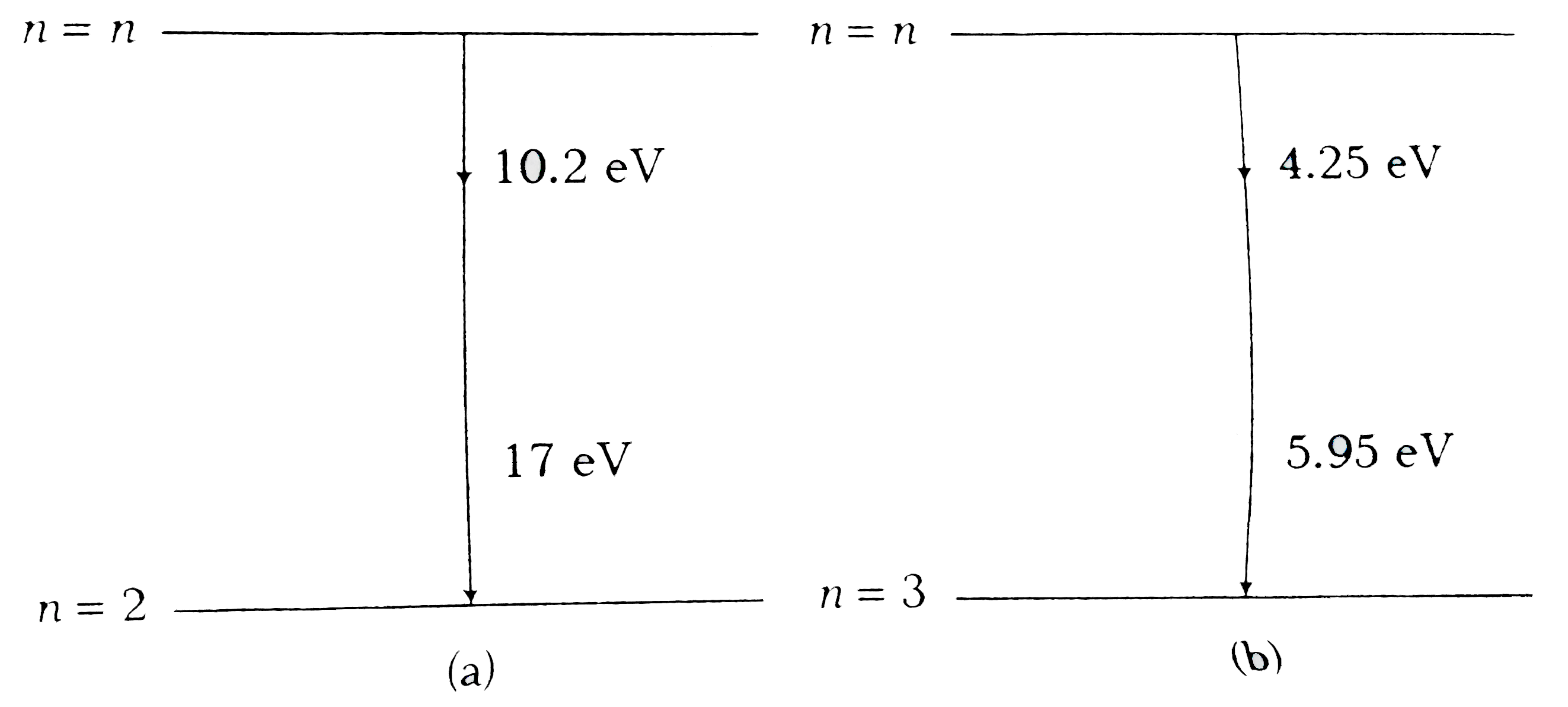A hydrogen like atom (atomic number Z) is in a higher excited state of quantum number n. The excited atom can make a transition to the first excited state by successively emitting two photons of energy 10.2 eV and 17.0 eV, respectively. Alternatively, the atom from the same excited state can make a transition to the second excited state by successively emitting two photons of energies 4.25 eV and 5.95 eV, respectively Determine the values of n and Z. (lonization energy of H-atom = 13.6 eV)
According to the question,

We, know energy of electron in nth is given by
ΔE=13.6Z2(1n21−1n22)
Case I
Energy emitted by photon, ΔE=10.20+17
=27.2 eV
So, 10.2+17=13.6Z2(122−1n2) (∴n1=2,n2=n)
27.2=13.6Z2(14−1n2) ....(i)
Case II
Energy emitted by photons, Δ4.25+5.95=10.2eV
4.25×5.95=13.6Z2(132−1n2) (∴n1=3,n2=n)
10.2=13.6Z2(19−1n2) ....(ii)
On divinding Eq. (i) by Eq. (ii) we get
27.2210.2=1/4−1/n21/9−1/n2
⇒ 27.29−27.2n2=10.24−10.2n2
⇒ 17.2n2=27.99−10.24
⇒ n2=36⇒n=6
Substituding the value of n in Eq. (i) , we get
27.2=13.6Z2(14−1n2)=13.6Z2(14−162)
=13.6Z2(14−136)=13.6Z2(9−136)=13.6Z2×29
Z2=9⇒Z=3
Topper's Solved these Questions
- ATOMSBOOK - DC PANDEY ENGLISHCHAPTER - ATOMSEXERCISE - Check point 12.1
14 Videos
- ATOMSBOOK - DC PANDEY ENGLISHCHAPTER - ATOMSEXERCISE - Check point 12.2
16 Videos
- ALTERNATING CURRENTBOOK - DC PANDEY ENGLISHCHAPTER - ALTERNATING CURRENTEXERCISE - JEE MAIN
62 Videos
- CAPACITORSBOOK - DC PANDEY ENGLISHCHAPTER - CAPACITORSEXERCISE - OBJECTIVE_TYPE
1 Videos
Similar Questions
A hydrogen like atom (atomic number z) is in a higher excited state of quantum number n. This excited atom can make a transition to the first excited state by successively emitting two photons of energies 10.2eV and 17.0eV respectively. Alternatively the atom from the same excited state can make a transition to the second excited state by successively emitting 2 photons of energy 4.25eV and5.95eV respectively. Determine the value of (n+z)
View SolutionA hydrogen like species (atomic number Z) is present in a higher excited state of quantum number n. This excited atom can make a transitionn to the first excited state by successive emission of two photons of energies 10.20 eV and 17.0 eV respectively. Altetnatively, the atom from the same excited state can make a transition to the second excited state by successive of two photons of energy 4.25 eV and 5.95 eVv respectively. Determine the value of Z.
View Solution
Knowledge Check
the energy required to excite an electron in hydrogen atom to its first excited state is
A8.5eVB10.2eVC12.7eVD13.6eVEnergy of H-atom in the ground state is -13.6 eV, hence energy in the second excited state is
A−6.8eVB−3.4eVC−1.51eVD−4.53eV
A hydrogen like atom (atomic number Z) is in a higher excited satte of quantum number n .This excited atom can make a transition to the first excited state by succesively emitting two photon of energies 10.20eV and 17.00eV .Alternatively, the atom from the same excited state can make a transition to the second excited state by successively emitting twio photon of energy 4.25ev and 5.95eV Determine the followings:
The atom during transition from n=1 to n=2 emit radiation in the region of
View SolutionThe ratio of the energies of the hydrogen atom in its first to second excited state is
View SolutionThe energy of an atom or ion in the first excited state is -13.6 eV. It may be
View SolutionWhen a hydrogen atom is excited from ground state to first excited state, then
View SolutionA hydrogen atom ia in excited state of principal quantum number n . It emits a photon of wavelength λ when it returnesto the ground state. The value of n is
View SolutionThe energy of the electron in the ground state of H-atom is −13.6eV. The energy of the first excited state will be
View Solution
